child restraint INFINITI QX60 2018 Owners Manual
[x] Cancel search | Manufacturer: INFINITI, Model Year: 2018, Model line: QX60, Model: INFINITI QX60 2018Pages: 490, PDF Size: 6.34 MB
Page 2 of 490
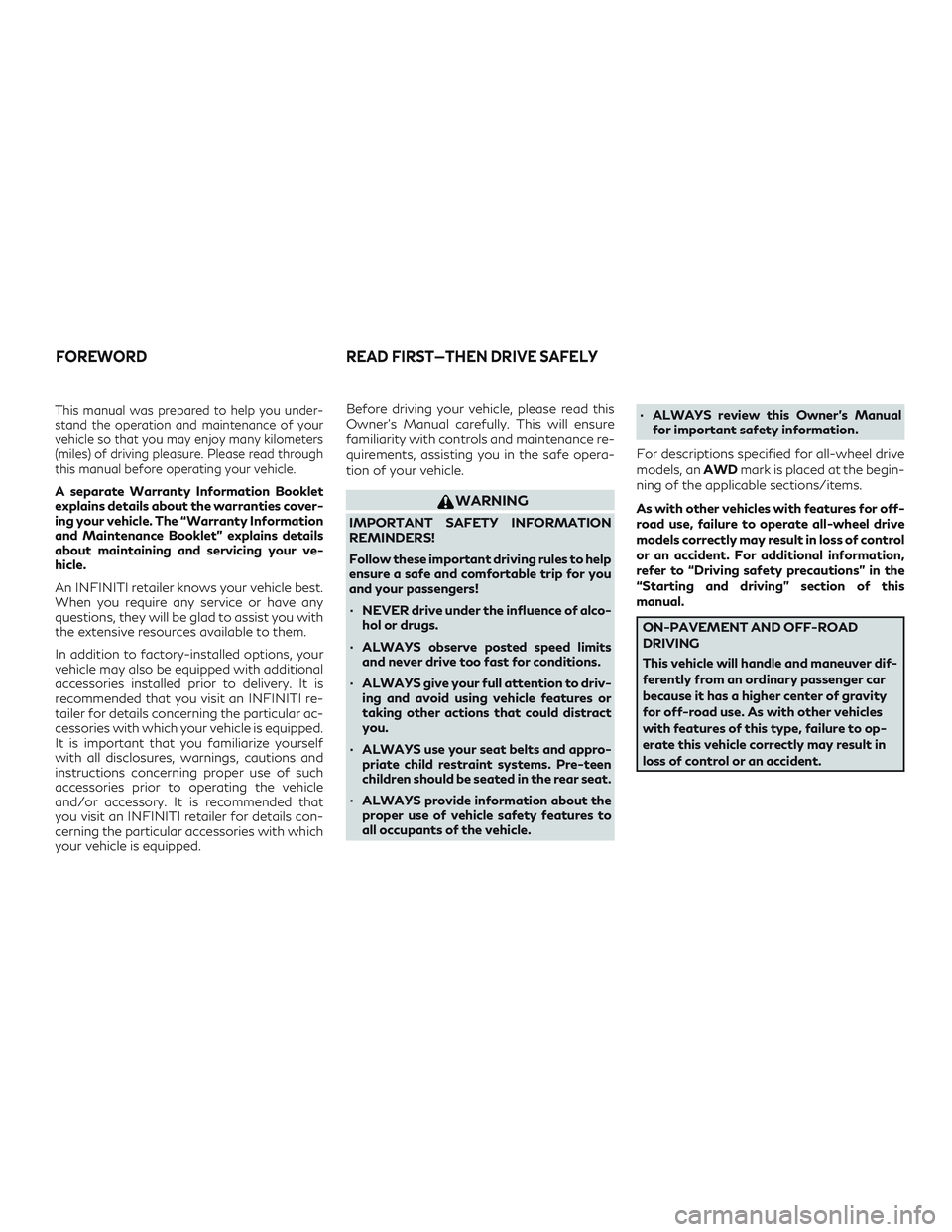
This manual was prepared to help you under-
stand the operation and maintenance of your
vehicle so that you may enjoy many kilometers
(miles) of driving pleasure. Please read through
this manual before operating your vehicle.
A separate Warranty Information Booklet
explains details about the warranties cover-
ing your vehicle. The “Warranty Information
and Maintenance Booklet” explains details
about maintaining and servicing your ve-
hicle.
An INFINITI retailer knows your vehicle best.
When you require any service or have any
questions, they will be glad to assist you with
the extensive resources available to them.
In addition to factory-installed options, your
vehicle may also be equipped with additional
accessories installed prior to delivery. It is
recommended that you visit an INFINITI re-
tailer for details concerning the particular ac-
cessories with which your vehicle is equipped.
It is important that you familiarize yourself
with all disclosures, warnings, cautions and
instructions concerning proper use of such
accessories prior to operating the vehicle
and/or accessory. It is recommended that
you visit an INFINITI retailer for details con-
cerning the particular accessories with which
your vehicle is equipped.Before driving your vehicle, please read this
Owner’s Manual carefully. This will ensure
familiarity with controls and maintenance re-
quirements, assisting you in the safe opera-
tion of your vehicle.WARNING
IMPORTANT SAFETY INFORMATION
REMINDERS!
Follow these important driving rules to help
ensure a safe and comfortable trip for you
and your passengers!
∙ NEVER drive under the influence of alco-
hol or drugs.
∙ ALWAYS observe posted speed limits and never drive too fast for conditions.
∙ ALWAYS give your full attention to driv- ing and avoid using vehicle features or
taking other actions that could distract
you.
∙ ALWAYS use your seat belts and appro- priate child restraint systems. Pre-teen
children should be seated in the rear seat.
∙ ALWAYS provide information about the proper use of vehicle safety features to
all occupants of the vehicle. ∙ ALWAYS review this Owner’s Manual
for important safety information.
For descriptions specified for all-wheel drive
models, an AWDmark is placed at the begin-
ning of the applicable sections/items.
As with other vehicles with features for off-
road use, failure to operate all-wheel drive
models correctly may result in loss of control
or an accident. For additional information,
refer to “Driving safety precautions” in the
“Starting and driving” section of this
manual.
ON-PAVEMENT AND OFF-ROAD
DRIVING
This vehicle will handle and maneuver dif-
ferently from an ordinary passenger car
because it has a higher center of gravity
for off-road use. As with other vehicles
with features of this type, failure to op-
erate this vehicle correctly may result in
loss of control or an accident.
FOREWORD READ FIRST—THEN DRIVE SAFELY
Page 8 of 490
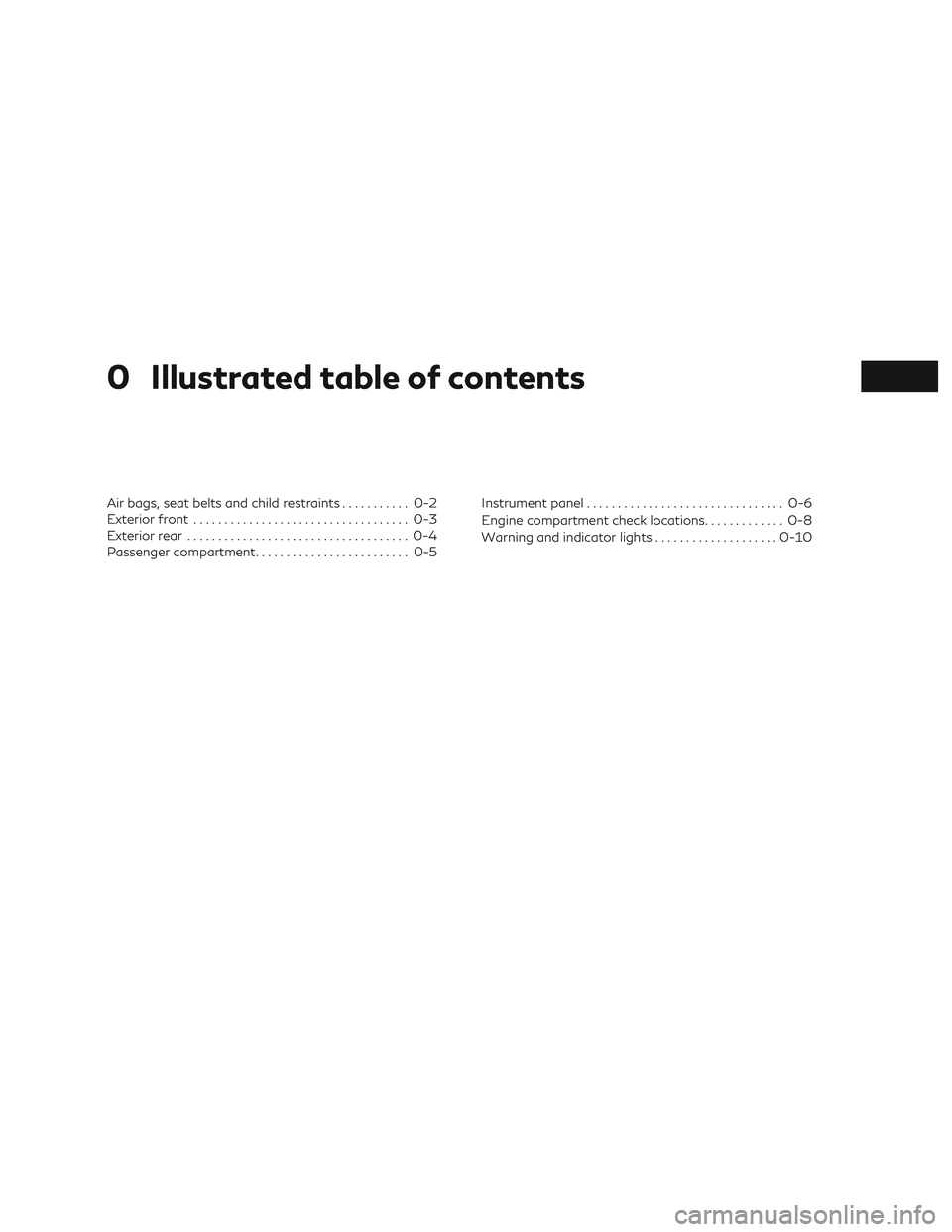
0 Illustrated table of contents
Air bags, seat belts and child restraints........... 0-2
Exterior front ................................... 0-3
Exterior rear .................................... 0-4
Passenger compartment ......................... 0-5 Instrument panel
................................ 0-6
Engine compartment check locations ............. 0-8
Warning and indicator lights ....................0-10
Page 9 of 490

1. Folding 3rd row bench (P. 1-2)
2. Folding 2nd row bench (P. 1-2)
3. Roof-mounted curtain side-impactand rollover supplemental air bag
(P. 1-47)
4. Head restraints (P.1-11)
5. Front seat belt with pretensioner(s)
and shoulder height adjuster
(P. 1-16, 1-47)
6. Supplemental front-impact air bags
(P.1-47)
7. Occupant classification sensor
(weight sensor) (P. 1-47)
8. Front seats (P. 1-2)
9. Front seat-mounted side-impact
supplemental air bag (P. 1-47)
10. LATCH (Lower Anchors and Tethers
for CHildren) (P. 1-26)
11. 2nd row seat top tether strap an-
chor (located on bottom of seatback)
(P. 1-26)
12. 3rd row bench seat top tether strap
anchor (located on bottom of seat-
back) (P. 1-26)
Refer to the page number indicated in paren-
theses for operating details.
LII2420
AIR BAGS, SEAT BELTS AND CHILD
RESTRAINTS
0-2Illustrated table of contents
Page 18 of 490

1 Safety—Seats, seat belts and
supplemental restraint system
Seats............................................1-2
Front power seat adjustment ..................1-3
2nd row bench seat adjustment ................1-5
3rd row bench seat adjustment ................1-7
Armrests ......................................1-8
Flexible seating ...............................1-8
Head restraints ................................. 1-11
Adjustable head restraint components ........1-12
Non-adjustable head restraint
components ................................. 1-12
Remove ...................................... 1-13
Removable (without Dual Head Restraint
DVD System only) ............................ 1-13
Install ........................................ 1-14
Adjust ....................................... 1-14
Folding head restraint ........................ 1-15
Seat belts ....................................... 1-16
Precautions on seat belt usage ...............1-16
Seat belt warning light .......................1-19
Child safety .................................. 1-19
Pregnant women ............................ 1-20
Injured persons ............................... 1-21
Pre-crash seat belts with comfort
function (front seats) (if so equipped) ..........1-21 Three-point type seat belt with retractor
......1-21
Seat belt extenders ........................... 1-25
Seat belt maintenance ....................... 1-26
Child restraints ................................. 1-26
Precautions on child restraints ...............1-26
LATCH (Lower Anchors and Tethers for
CHildren) system ............................ 1-28
Rear-facing child restraint installation
using LATCH ................................ 1-31
Rear-facing child restraint installation
using the seat belts .......................... 1-33
Forward-facing child restraint installation
using LATCH ............................... 1-36
Forward-facing child restraint installation
using the seat belts .......................... 1-38
Installing top tether strap
(2nd row bench seat) ........................ 1-42
Installing top tether strap
(3rd row bench seat) ........................ 1-42
Booster
seats ............................... 1-43
Supplemental Restraint System (SRS) ............1-47
Precautions on SRS .......................... 1-47
Supplemental air bag warning labels .........1-65
Supplemental air bag warning light ...........1-65
Page 19 of 490

WARNING
∙ Do not ride in a moving vehicle when theseatback is reclined. This can be danger-
ous. The shoulder belt will not be against
your body. In an accident, you could be
thrown into it and receive neck or other
serious injuries. You could also slide under
the lap belt and receive serious internal
injuries. ∙ For the most effective protection when
the vehicle is in motion, the seat should be
upright. Always sit well back and upright
in the seat with both feet on the floor and
adjust the seat properly. For additional
information, refer to “Precautions on
seat belt usage” in this section.
∙ After adjustment, gently rock in the seat to make sure it is securely locked.
∙ Do not leave children unattended inside the vehicle. They could unknowingly acti-
vate switches or controls or make the ve-
hicle move. Unattended children could
become involved in serious accidents. ∙ To help avoid risk of injury or death
through unintended operation of the ve-
hicle and/or its systems, do not leave
children, people who require the assis-
tance of others or pets unattended in
your vehicle. Additionally, the tempera-
ture inside a closed vehicle on a warm day
can quickly become high enough to cause
a significant risk of injury or death to
people and pets.
∙ Do not adjust the driver’s seat while driv- ing so full attention may be given to ve-
hicle operation. The seat may move sud-
denly and could cause loss of control of
the vehicle.
∙ The seatback should not be reclined any more than needed for comfort. Seat belts
are most effective when the passenger
sits well back and straight up in the seat.
If the seatback is reclined, the risk of slid-
ing under the lap belt and being injured is
increased.
CAUTION
When adjusting the seat positions, be sure
not to contact any moving parts to avoid
possible injuries and/or damage.
ARS1152
SEATS
1-2Safety—Seats, seat belts and supplemental restraint system
Page 23 of 490

One touch walk-in function
The 3rd row can be accessed from outside
the vehicle by using the seatback release le-
ver located on the upper outboard side of the
seatback on the 2nd row bench seat. If a child
safety seat is installed on the passenger’s side
of the 2nd row seat, the 3rd row can be
accessed without removing the child safety
seat.Multi-mode
WARNING
When returning the seat to its original po-
sition, confirm that the seat and seatback
are locked properly.
CAUTION
∙ Be careful not to pinch your hand or foot
or bump your head when operating the
walk-in seat.
∙ Do not drive with the 2nd row seat tipped up.
∙ Be careful not to allow the 2nd row seat to pinch, hit any part of your body or
other people when operating the 2nd row
seat. Make sure the seat path is clear of
all objects before moving the seat.
To enter the 3rd row from outside the ve-
hicle, lift up on the seatback lever located on
the upper outboard side of the seatback on
the 2nd row bench seat. This will release the
back of the seat and fold up the seat cushion.
This will also release the seat tracks so you
will be able to slide the seat forward or back-
ward. Slide the entire seat forward for access to the
3rd row.
To return the seat to a locked position, push
the upper seatback rearward until the seat-
back and tracks are locked. Push the seat
cushion down.
Child seat access mode
The passenger’s side of the 2nd row seat can
be slid forward for easy entry or exit from the
3rd row bench seat without a child safety
seat being removed.
To enter the 3rd row from outside the ve-
hicle, lift up on the seatback lever located on
the upper outboard side of the seatback on
the 2nd row bench seat. This will release the
seatback. Then tilt the seat and release the
tracks so you will be able to slide the seat
forward or backward.
Slide the entire seat forward for access to the
rear seats.
To return the seat to a locked position, push
the upper seatback rearward until the seat-
back and track are locked.
LRS2142
1-6Safety—Seats, seat belts and supplemental restraint system
Page 24 of 490

WARNING
∙ Do not leave a child in the child safetyseat when operating the child seat access
mode.
∙ When returning the seat to its original position, confirm that the seat and seat-
back are locked properly.
CAUTION
∙ Be careful not to pinch your hand or footor bump your head when operating the
walk-in seat.
∙ Do not drive with the 2nd row seat tipped up.
∙ Be careful not to allow the 2nd row seat to pinch, hit any part of your body or
other people when operating the 2nd row
seat. Make sure the seat path is clear of
all objects before moving the seat. Exiting the 3rd row
To exit the 3rd row from either seating posi-
tion, lift the upper seatback release lever to
the uppermost position. This will release the
back of the seat, then fold the seat cushion
up and release the tracks.
Slide the entire seat forward.
To return the seat to a locked position, push
the upper seatback rearward until the seat-
back and track are locked.
WARNING
When returning the seat to its original po-
sition, confirm that the seat and seatback
are locked properly.
CAUTION
Be careful not to pinch your hand or foot or
bump your head when operating the
walk-in seat.
3RD ROW BENCH SEAT
ADJUSTMENT
Reclining
To recline the seatback, pull up on the latch
located on the outside corner of each seat-
back. Lean back until the desired angle is
obtained.
To bring the seatback forward again, pull up
on the latch and pull the seatback upright
until the desired angle is obtained.
LRS2147
Safety—Seats, seat belts and supplemental restraint system1-7
Page 34 of 490
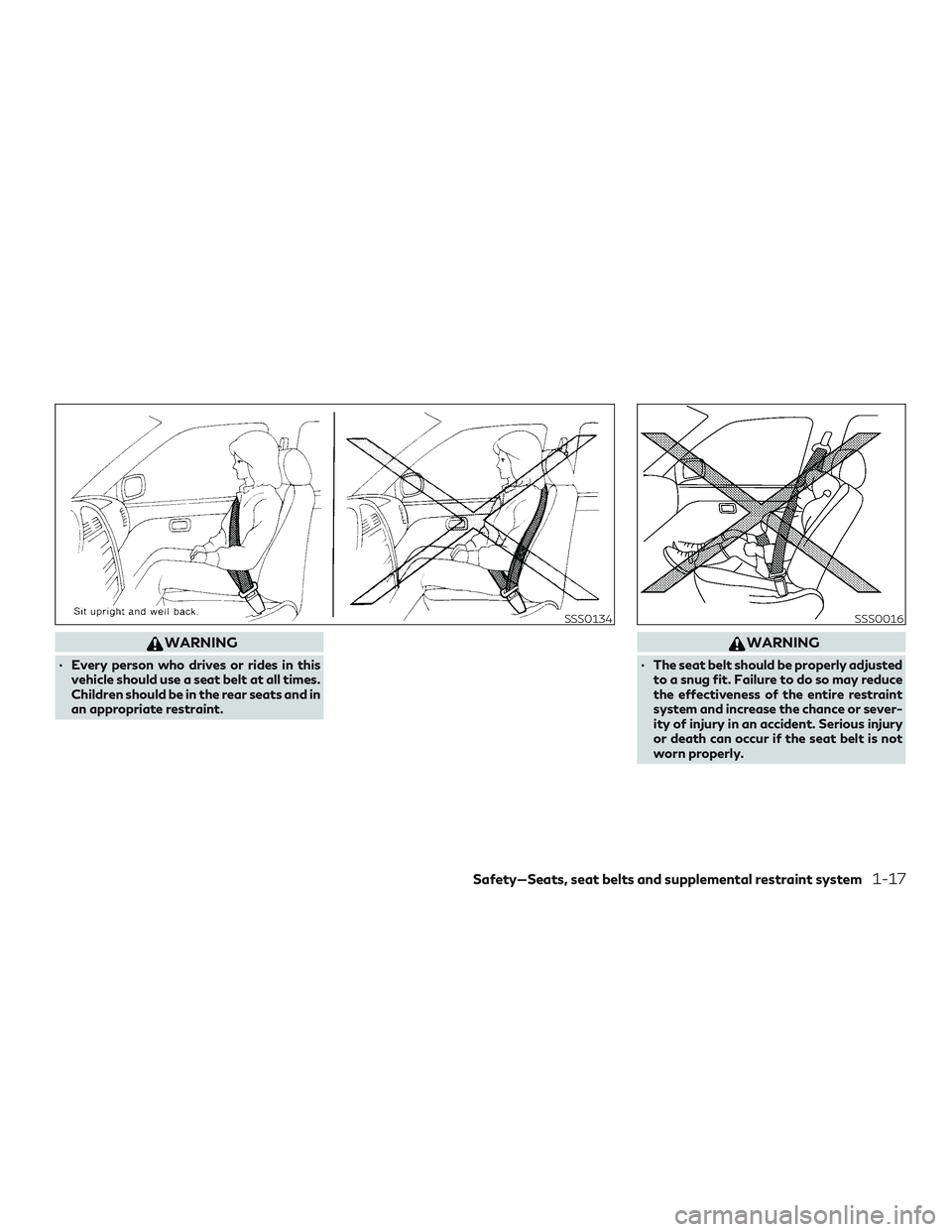
WARNING
∙ Every person who drives or rides in thisvehicle should use a seat belt at all times.
Children should be in the rear seats and in
an appropriate restraint.
WARNING
∙ The seat belt should be properly adjustedto a snug fit. Failure to do so may reduce
the effectiveness of the entire restraint
system and increase the chance or sever-
ity of injury in an accident. Serious injury
or death can occur if the seat belt is not
worn properly.
SSS0134SSS0016
Safety—Seats, seat belts and supplemental restraint system1-17
Page 35 of 490
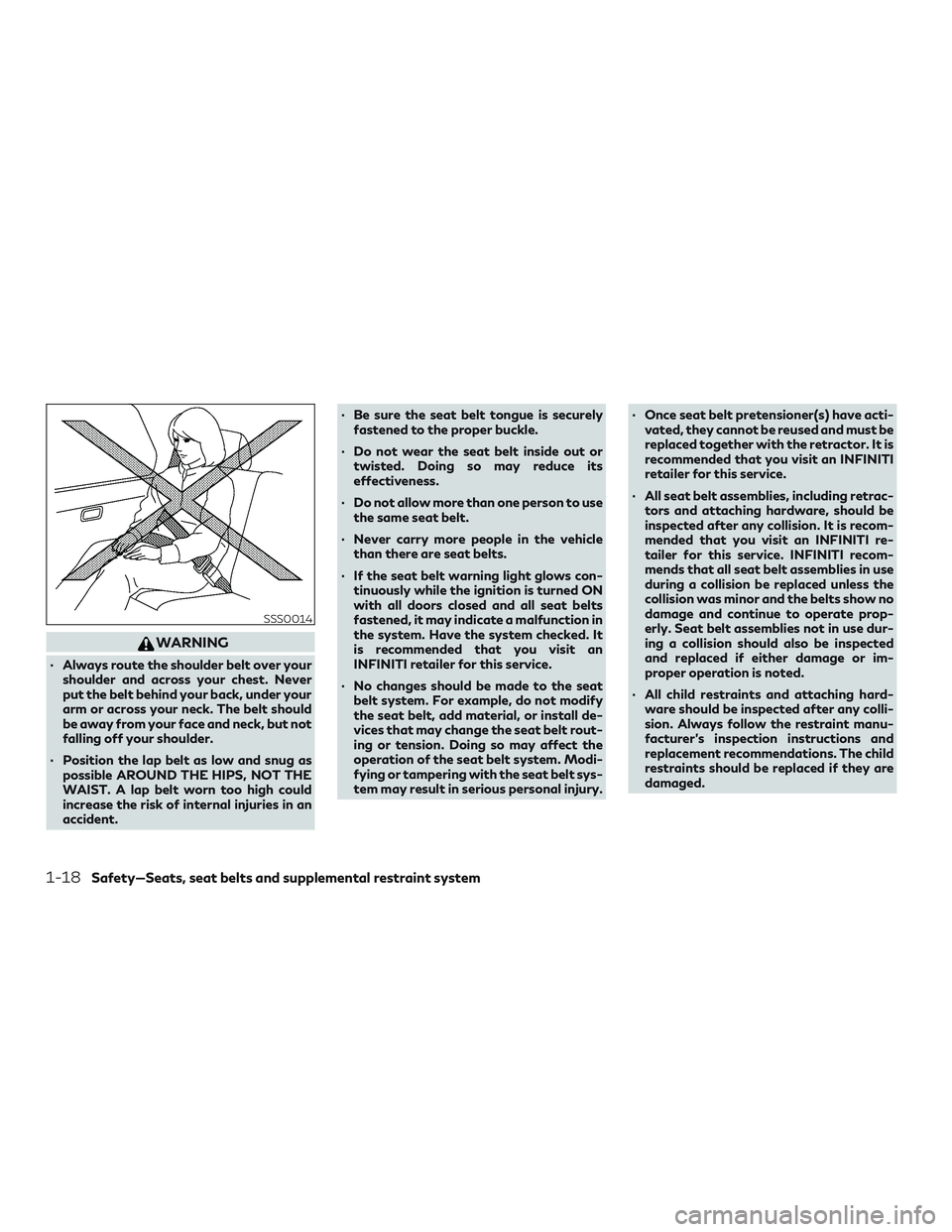
WARNING
∙ Always route the shoulder belt over yourshoulder and across your chest. Never
put the belt behind your back, under your
arm or across your neck. The belt should
be away from your face and neck, but not
falling off your shoulder.
∙ Position the lap belt as low and snug as possible AROUND THE HIPS, NOT THE
WAIST. A lap belt worn too high could
increase the risk of internal injuries in an
accident. ∙ Be sure the seat belt tongue is securely
fastened to the proper buckle.
∙ Do not wear the seat belt inside out or twisted. Doing so may reduce its
effectiveness.
∙ Do not allow more than one person to use the same seat belt.
∙ Never carry more people in the vehicle than there are seat belts.
∙ If the seat belt warning light glows con- tinuously while the ignition is turned ON
with all doors closed and all seat belts
fastened, it may indicate a malfunction in
the system. Have the system checked. It
is recommended that you visit an
INFINITI retailer for this service.
∙ No changes should be made to the seat belt system. For example, do not modify
the seat belt, add material, or install de-
vices that may change the seat belt rout-
ing or tension. Doing so may affect the
operation of the seat belt system. Modi-
fying or tampering with the seat belt sys-
tem may result in serious personal injury. ∙ Once seat belt pretensioner(s) have acti-
vated, they cannot be reused and must be
replaced together with the retractor. It is
recommended that you visit an INFINITI
retailer for this service.
∙ All seat belt assemblies, including retrac- tors and attaching hardware, should be
inspected after any collision. It is recom-
mended that you visit an INFINITI re-
tailer for this service. INFINITI recom-
mends that all seat belt assemblies in use
during a collision be replaced unless the
collision was minor and the belts show no
damage and continue to operate prop-
erly. Seat belt assemblies not in use dur-
ing a collision should also be inspected
and replaced if either damage or im-
proper operation is noted.
∙ All child restraints and attaching hard- ware should be inspected after any colli-
sion. Always follow the restraint manu-
facturer’s inspection instructions and
replacement recommendations. The child
restraints should be replaced if they are
damaged.
SSS0014
1-18Safety—Seats, seat belts and supplemental restraint system
Page 36 of 490
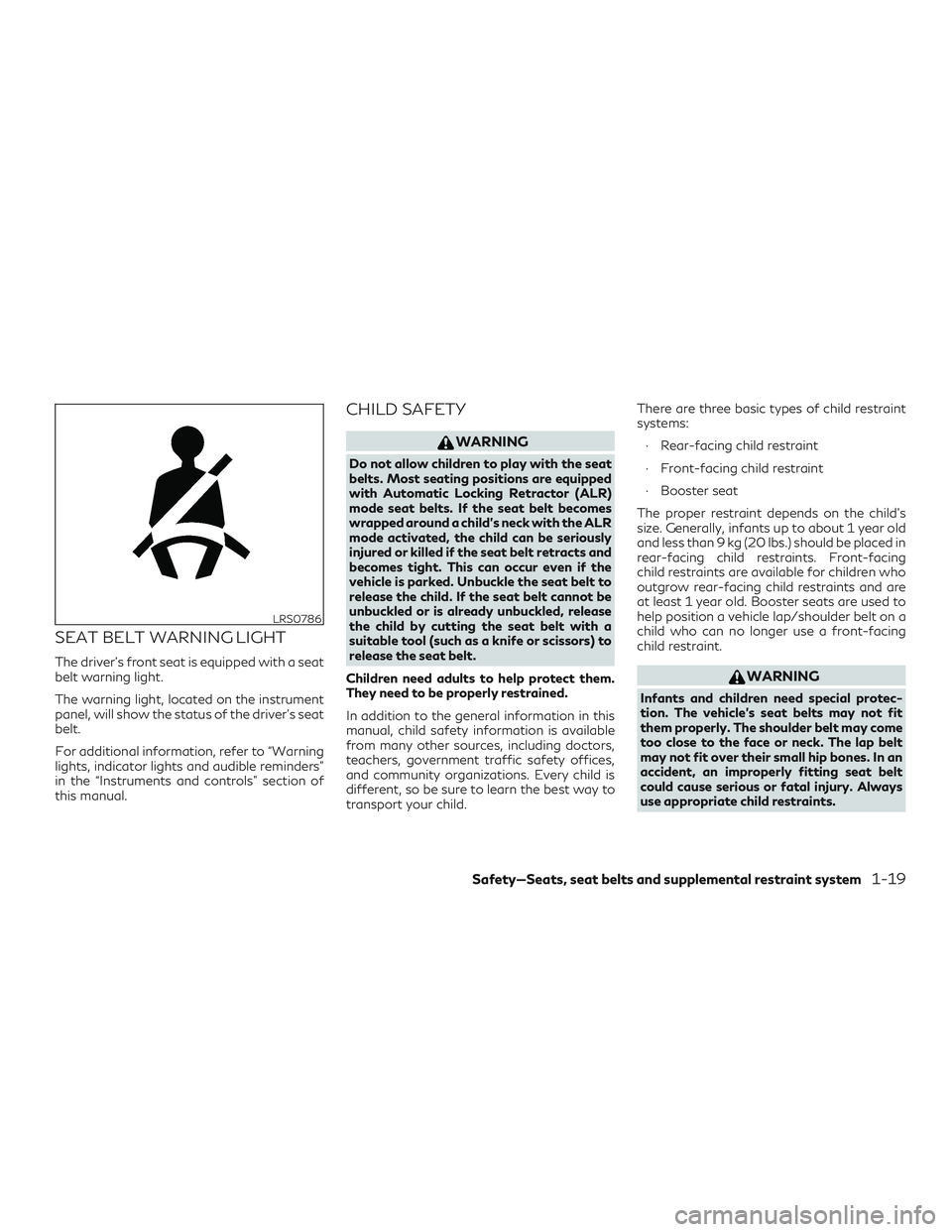
SEAT BELT WARNING LIGHT
The driver’s front seat is equipped with a seat
belt warning light.
The warning light, located on the instrument
panel, will show the status of the driver’s seat
belt.
For additional information, refer to “Warning
lights, indicator lights and audible reminders”
in the “Instruments and controls” section of
this manual.
CHILD SAFETY
WARNING
Do not allow children to play with the seat
belts. Most seating positions are equipped
with Automatic Locking Retractor (ALR)
mode seat belts. If the seat belt becomes
wrapped around a child’s neck with the ALR
mode activated, the child can be seriously
injured or killed if the seat belt retracts and
becomes tight. This can occur even if the
vehicle is parked. Unbuckle the seat belt to
release the child. If the seat belt cannot be
unbuckled or is already unbuckled, release
the child by cutting the seat belt with a
suitable tool (such as a knife or scissors) to
release the seat belt.
Children need adults to help protect them.
They need to be properly restrained.
In addition to the general information in this
manual, child safety information is available
from many other sources, including doctors,
teachers, government traffic safety offices,
and community organizations. Every child is
different, so be sure to learn the best way to
transport your child. There are three basic types of child restraint
systems:
∙ Rear-facing child restraint
∙ Front-facing child restraint
∙ Booster seat
The proper restraint depends on the child’s
size. Generally, infants up to about 1 year old
and less than 9 kg (20 lbs.) should be placed in
rear-facing child restraints. Front-facing
child restraints are available for children who
outgrow rear-facing child restraints and are
at least 1 year old. Booster seats are used to
help position a vehicle lap/shoulder belt on a
child who can no longer use a front-facing
child restraint.
WARNING
Infants and children need special protec-
tion. The vehicle’s seat belts may not fit
them properly. The shoulder belt may come
too close to the face or neck. The lap belt
may not fit over their small hip bones. In an
accident, an improperly fitting seat belt
could cause serious or fatal injury. Always
use appropriate child restraints.
LRS0786
Safety—Seats, seat belts and supplemental restraint system1-19